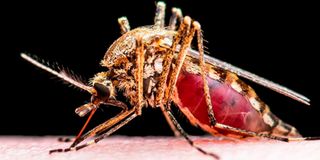Yellow fever vaccination starts in Isiolo and Garissa counties

An Aedes Aegypti mosquito that causes yellow fever.
The Ministry of Health and other partners have launched a 10-day mass vaccination drive against yellow fever in Isiolo and Garissa counties targeting over 700,000 people.
Seven people have died and 71 have been infected since January 12, when the first cases were detected in Isiolo exhibiting symptoms such as fever, headache, nausea, fatigue and vomiting.
In March, the government declared an outbreak in Kenya after the disease claimed three lives in Garbatulla, with Wajir, Garissa, Meru, Samburu, Baringo and Turkana counties put on high alert.
Launching the campaign, acting Director-General of Health Patrick Amoth said the drive targets all people aged between nine months and 60 years in Isiolo County and Balambala and Lagdera sub-counties in neighbouring Garissa County.
He assured residents of the two counties that the vaccine is safe, saying a single dose would offer them lifetime protection from the disease.
“I am appealing to all residents within the age bracket to take the jab to protect themselves and their families from the disease,” Dr Amoth said, asking the county government to ensure people with disabilities are reached.
The jab will be offered at public health facilities, schools, markets and mobile posts in far-flung areas.
The disease is spread by the Aedes aegypti mosquito and previous outbreaks in Kenya, which is classified as a high-risk country, were reported in 1992, 1993, 1995 and 2011.
Reports indicate a small proportion of patients who contract the virus develop symptoms and about half of them die within seven to 10 days.
Isiolo Deputy Governor Abdi Issa said the vaccination campaign was crucial in ensuring the disease does not spread and affect more residents.
There is increased risk of transmission due to massive movement by pastoralists in search of water and pastures due to the drought that has resulted in the drying of water sources and depletion of pastures.
Dr Issa said the highly infectious disease leads to death of almost 50 percent of those infected if they fail to get early medical attention.
“If not well managed, yellow fever could claim many lives. Our people should come out in large numbers and take the jab,” he appealed while warning politicians against politicising health issues.
He asked residents to use treated mosquito nets and clear bushes in their villages to keep the virus at bay.
Isiolo Health executive Wario Galma appealed for logistical help, saying the devolved unit did not have enough resources to cover the vast county occupying 25,336 square kilometres.
“We still require support from partners in terms of vehicles to enable our officers to reach the hard to reach areas within the 10-days window,” Mr Galma said, lauding the government for assisting the devolved unit to reduce the risk of transmission.
Dr Amoth asked the two counties to scale up immunisation coverage for other vaccines such as a double dose of measles rubella for children aged below five to prevent outbreak of diseases.
Dr Sergon Kibet, from the World Health Organisation (WHO), said yellow fever vaccination is vital in protecting the lives of vulnerable populations and urged residents in the two counties to turn up for the jab.
The WHO recommends vaccination and vector control to prevent transmission by use of repellents and treated mosquito nets.





